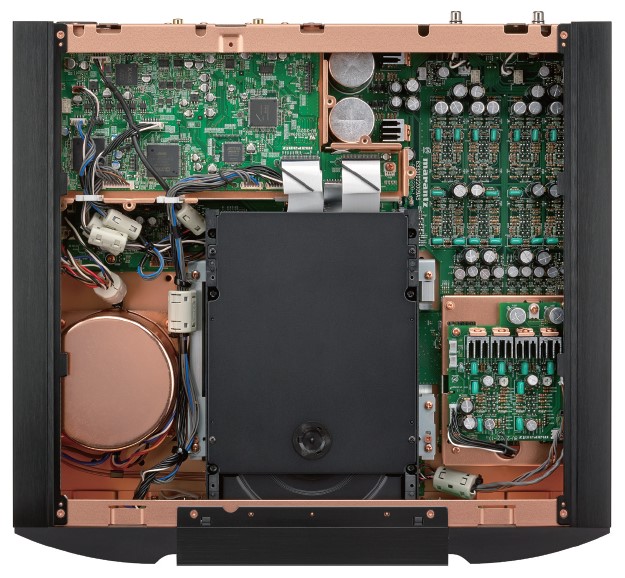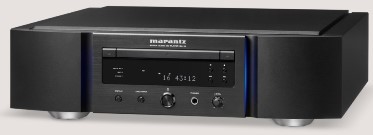Just like Rodney Dangerfield, the Marantz SA-10 CD/SACD Player and DAC gets no respect. This is a shame as the SA-10 could well be the best sounding, best built player/DAC anywhere close to its $6990 list price. At the top of the Marantz line of digital products, the SA-10 could easily maintain that preeminent position for years to come.
There have been a ‘boatload’ of mergers and acquisitions of audio companies over the last few years. Marantz is owned by Sound United, LLC, a California company, and joins a portfolio that includes other well-known brands including Denon, Polk, Definitive Technology, HEOS, Boston Acoustics, and Classé.

Like all Marantz products, this fine component benefits from the vast engineering and manufacturing capability of Marantz Japan. The SA-10 has the latest SACD-M3 transport mechanism, and utilizes a product-specific version of Marantz’s proprietary HDAM analog line-level amplifier modules. The SA-10 can play CDs and SACDs and has digital outputs on coax and optical for further listening options. The SA-10 can be easily configured, with a click on a set-up button, to operate as a dedicated DAC with USB, coax and optical inputs. The USB input can handle up to 32-bit 384 kHz data; other inputs and disc are limited to 24-bit 192 kHz. SACD playback is compatible with DSD256. The unit weighs almost 41 pounds due to the very solid construction, copper plated enclosure and separation panels, and large toroidal power transformer.
Balanced XLR (pin 2 positive) and unbalanced RCA outputs are provided. There is no trigger functionality, but the power switch maintains its last position so remote turn-on and -off using a switched power outlet is a viable substitute. When in DAC mode, all lights and CD functionality are disabled, but the front panel display will momentarily show the incoming sample rate when it is changed, and then turn off. The focus of this review is on the performance of the digital to analog converter. SACD was not put to the test.

Other components on hand during the long review period includes a VPI Aries 3 turntable with a Tri-Planar U2 SE or Kuzma 4-Point tonearm, Clearaudio Ovation turntable with Clearaudio Universal, Tri-planar and Origin Live Agile tonearms; ZYX UNIverse Optimum, Miyajima Destiny and Miyajima Madake moving coil cartridges; B.M.C. MCCI ULN, Aurorasound VIDA Prima and Elac Alchemy PPA-2 phono preamplifiers; custom Windows 10 music computer running JRiver Media Center; Wyred 4 Sound DAC 2v2SE 10th Anniversary DA converter; RME ADI-2 Pro AD/DA converter with external power supply; Soulution 325 with phono, Benchmark HPA-4, Pass Labs XP-22, BAT VK-43SE, and Wyred 4 Sound STP-SE Stage 2 preamplifiers; Valvet E2 SE, Wyred 4 Sound ST-750LE, PS Audio Stellar S300, Conrad-Johnson Classic 62 SE, Valvet A4e, and Benchmark AHB2 power amplifiers; Focal Sopra 1, Magico S1 MkII loudspeakers, and Focal Chorus 714 and Dynaudio Evoke 30 loudspeakers borrowed from the HT system. The lowest few Hertz are engaged by a pair of JL Audio e110 subwoofers. The audio cabling is Audioquest WEL Signature, Cardas Clear Beyond and Mogami interconnects and speaker cables. USB cables are Straight Wire USB-F. Power protection and purification are provided by an Audioquest Niagara 5000 or PS Audio Dectet for the preamplifiers and source components, and a PS Audio Quintet for the power amplifiers. The Quintet includes a standard 1/8″ trigger for remote turn-on and -off of power amplifiers that lack a 12V remote trigger. Power cords include my DIY power cord, Straight Wire Pro Thunder and Audioquest Blizzard 20A (for the Niagara 5000).

I use a Windows 10 64-bit computer, running JRiver Media Center, as a music server. This has a PCI-e add-on USB card to maximize signal quality. I usually use the computer’s internal CD/DVD/Blu-Ray drive to rip CDs as 16/44.1 WAV files and play back at 32 bit (2 times the original bit depth) 176.4 kHz (4 times the original sample rate. This seems to sound the best as the upsampling math is simpler than, for example, 24/96 which would require bit depth to be interpolated at 1.5 times the original, and sample rate at 2.1768 times the original. For best sound, digital upsampling seems to prefer whole numbers! My LP rips, using the RME ADI-2 Pro AD/DA converter, are recorded at 32-bit 192 kHz and played at 32-bit 384 kHz. This format requires about 1.8-2 GB of storage space per side of an LP record. For comparison, a CD requires about 700 MB for the whole album.
The user can adjust settings for dither to minimize quantization errors, and also choose one of four settings for the Noise Shaper, which changes “linearity and noise characteristics in the audible range using digital feedback. The measurements are the same but the sound quality changes.” Changing the dither and Noise Shaper settings have an audible effect, but were left at the default settings for this evaluation.
From the Web: “DSD is at the heart of the way the SA-10 handles digital audio: PCM and DXD inputs are all upconverted to DSD at 11.2MHz using the proprietary MMM-Stream converter within the player, and then the high-frequency signal produced is processed by the unique MMM-Conversion stage, used in place of a conventional DAC, to produce the analog output.”
The differences between the sound of an LP playing on the turntable compared to the sound of high resolution WAV files played back through the SA-10 are extremely small. The upper frequencies are just a tiny bit less open or airy, and stage depth is also minimally shallower. These conclusions required repeated A-B type comparisons to confirm with any reliability and importantly, would be influenced by the recording process and are not necessarily a limitation of playback through the SA-10. In daily use, the differences are so small as to be easily overlooked. There was actually a very small preference for some 192 kHz recordings vs the 384 kHz music files because the higher resolution music occassionally has a slight edge or sharpness that is not on the LP. This was attributed to the $1,700 RME AD converter’s working at the limits of its design and not to the quality of the Marantz SA-10’s playback. But this preference still required multiple A-B comparisons to reliably identify the difference. Of course, a 192 kHz music file requires half the storage space as does a 384 kHz recording.
The Marantz SA-10 changes from high resolution playback to any other resolution with a quiet click, instantly, while the display lights up for a second or two to let you know that the SA-10 is following the input requirements. This change takes just a couple of seconds and has never failed or became “glitchy”. The Marantz DAC simply does what JRiver Media Center tells it to do, every time. The Marantz is also the computer’s DAC, serving when Google Chrome is showing a movie on Netflix or Baby Yoda on CBS All Access. The computer’s Sound default is 32-bit 192 kHz. The SA-10 delivers such a large, saturated sound field that surround sound is rarely missed.
The SA-10 has remarkable resolution from the lowest bass to the upper treble. The treble range is relatively warmer and less crisp than the Wyred 4 Sound DAC-2v2SE 10th Anniversary Limited Edition digital-to-analog converter. This is not a quality issue, but rather one of presentation or character that is important for good system matching and listener preference. The SA-10 might dig just a bit deeper into the lowest level of each note, but this is uncertain.

The SA-10 presents complete tones, including their harmonics, in a very natural and realistic manner. This contributes to a dense, fully energized sound stage with exceptional separation of performers on the stage. Brass instruments have very correct bite and texture. Cymbals have a natural metallic sheen. Piano has superb tone and a special truthfulness. Harmonics have a very linear and long-lasting fade into pure-black nothingness. Files from CD that are 16-bit 44.1 kHz, upsampled by JRiver Media Center to 32-bit 176.4 kHz – 2x the bit depth and 4x the sample rate – sound very complete and enjoyable.
Used as a CD player, the sound of the SA-10 is comparable to those same CDs ripped to digital files. The Marantz SA-10 is a superb and perfectly reliable DAC, easily handling very high-resolution digital files and delivering sound quality at a level only equaled by the original medium. With outstanding build quality, simple user interface, and perfect compatibility with any normal input signal, this is a component that does its job so well that an “upgrade” seems entirely superfluous. The Marantz SA-10 is a reference-level component that will make its owner happy for many years.
Overall Rating: 9.5 LPs – borderline 10 LPs
Link to manufacturer: Marantz Audio

